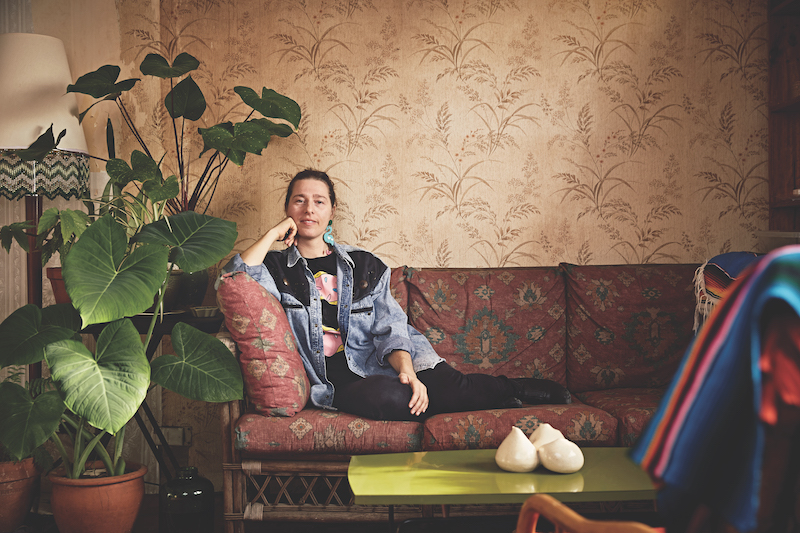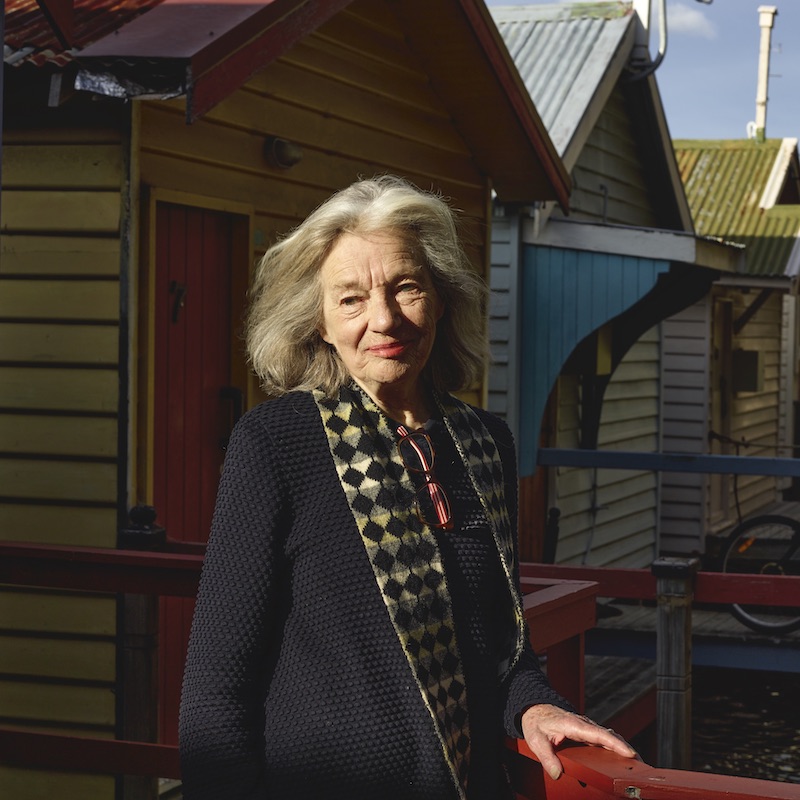Cigdem Aydemir: Beyond the veil
Cigdem Aydemir’s practice dissects what it means to be Muslim. Her latest work considers the symbolic and cultural potency of the veil and its connection to hair.
Words: Briony Downes
Photography: Nick De Lorenzo
Cigdem Aydemir’s The Ride (2017) contains an image I keep coming back to. Two women sit astride a Harley Davidson, the uninhabited horizon of an expansive landscape spread out alongside them. The driver is Aydemir, dressed in leather and wearing biker boots, a black headscarf billowing out behind her like a freedom flag. The passenger leans gently on Aydemir’s shoulder, holding on tightly as they ride together through the landscape.
When I speak with Sydney-based Aydemir about The Ride she tells me it was actually a performance created for Perth’s Proximity Festival – filmed 99 times and constructed on a set. The beefy Harley was noisy and vibrating with power, yet remained stationary. Industrial fans created the wind sweeping up Aydemir’s headscarf. The landscape was recorded near Hay in south western New South Wales and during each performance, Midnight Oil songs were blasted onto the set. Reminiscent of Mad Max fearlessly tearing across the desert in a scrap-metal two-wheeler, The Ride flips our expectations of who typically rescues who. “Tied up with being a Muslim woman is this notion we need to be rescued, that we are oppressed,” Aydemir says. “Turning this idea on its head, it was nice to be the rescuer. We had this moment together, me and the other participant. Riding through the landscape, music blasting.”
The centrepiece of The Ride is the veil, a consistent visual symbol seen throughout Aydemir’s video, performance and installation work. With Turkish Muslim heritage, Aydemir chose to start wearing the veil at age 10 and wore it until her early 20s. Wearing the veil in her formative teenage years cemented it as a major part of her identity and as a result, Aydemir’s oeuvre is strongly focused on dissecting what it means to be Muslim from a personal, social and political standpoint. Continually challenging notions of the veiled woman across gender and religion, an additional element in Aydemir’s work is humour. She sums up its importance: “African American poet Langston Hughes once wrote that, ‘Humour is your own unconscious therapy. Like a welcome summer rain, humour may suddenly cleanse and cool the earth, the air, and you.’ It’s the little bit of humour that can give you perspective, it cools the emotions and makes sense of the world.”
Completing her Master of Fine Art in 2015 at Sydney College of the Arts, Aydemir’s research interests revolve around how Muslim women are portrayed in Western culture, with an emphasis on female dress. Also exploring post-colonial history and the act of revealing through concealing – as seen in Plastic Histories (2014-16), a public art project where town statues were covered in hot pink plastic – Aydemir’s practice has taken her to South Africa, Istanbul and multiple locations around Australia. In 2012, she was awarded the Edna Ryan Award for Creative Feminism and in 2013, her video performance Bombshell, a niqab recreation of Marilyn Monroe’s white-dress-on-a-subway-vent scene in The Seven Year Itch, won the Redlands Konica Minolta Art Prize in the Emerging Artist category.
Aydemir’s latest work, Veils on Veils (2020) considers the symbolic and cultural potency of the veil and its connection to hair. Veils on Veils is similar in content to earlier work like Whirl (2015) a filmed sequence depicting Aydemir blow drying her headscarf – a piece that went on to become a finalist in the 2016 Blake Prize and later shown at Melbourne’s Centre for Contemporary Photography (2018).
The new series comprises still images and video of veils made to look like exaggerated hairstyles. With each hairstyle resembling the colourful bouffants and towering piles of curls seen in drag culture, Aydemir explains the work’s background: “There’s a long history of Muslim women wearing wigs in order to get by in society. When headscarves were banned in Turkey, there were images of elderly women wearing a wig on top of their headscarf, just so they could go to their child’s graduation or attend official ceremonies.”
For Veils on Veils, Aydemir worked with Sydney milliner Rick McGill, known for designing spectacular headpieces for stage productions of Priscilla Queen of the Desert. Together they constructed a collection of hybrid headscarves that question the disconnection between veil and hair.
“The veil has come to represent being Muslim and ideas of oppression – all these additional meanings come to the surface with the veil,” says Aydemir. “When we think of hairstyles none of that happens. What Veils on Veils is saying is that hairstyles are like veils. They still communicate. The way we choose to wear our hair is full of meaning and reflects on how we are situated in society.”
Further into 2020, a video from the Veils on Veils series is slated to appear on the University of Sydney Broadway Screen, a huge digital billboard in the Sydney CBD. Viewers can expect to see Aydemir tossing and flicking her long headscarf around like hair, replicating the head movements seen in shampoo commercials.
“I was really interested in using the Broadway Screen as a potential space where I could blur the boundaries between art and advertising,” Aydemir says.
Commissioned by UTS for its digital art program, Aydemir’s work will join screen-based contributions from Daniel Crooks, Ishmael Marika and Patrina Munuŋgurr (The Mulka Project) and Grant Stevens.
“This work takes the concept of the veil to another level. There’s definitely humour involved with me playing around with curls made of fabric, impersonating iconic Western women. I’m hoping it will be a thought-provoking, entertaining piece people can think about.”
This article was published in Art Collector issue 93, July to September 2020.









